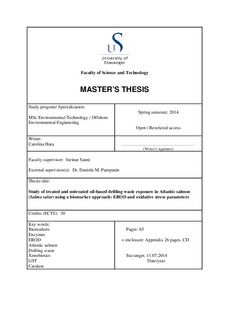| dc.contributor.author | Hara, Carolina | |
| dc.date.accessioned | 2015-01-13T13:07:29Z | |
| dc.date.available | 2015-01-13T13:07:29Z | |
| dc.date.issued | 2014-07-11 | |
| dc.identifier.uri | http://hdl.handle.net/11250/274005 | |
| dc.description | Master's thesis in Environmental technology | nb_NO |
| dc.description.abstract | This thesis presents an in vitro study evaluating if detoxification and oxidative stress enzymes ethoxyresorufin-O-dethylase (EROD), glutathione S-transferase (GST) and catalase (CAT) can reflect the effect thermally treated and untreated oil-based drilling waste has on Atlantic salmon parr (Salmo salar), and how these biomarkers can be used in future monitoring of drilling waste discharges. Fish were exposed for 3, 7 and 14 days to high (1 ppm oil) and low (0.1 ppm oil) doses of treated and untreated drilling waste, followed by a one week recovery period. EROD analysis was performed fluorometrically using NADPH as a substrate. GST and CAT activities were determined photometrically utilising CDNB and H2O2 as substrates. Values from all three assays were protein normalised. The results showed that EROD activity in fish exposed to the high dose of untreated drilling waste peaked after 3 days of exposure reaching an average of 3.7 ± 4.2 nmol/min/mg protein. A secondary rise was observed after 14 days, continuing post-recovery. EROD activity in fish exposed to the high dose of treated waste peaked at 4.0 ± 4.3 nmol/min/mg protein after 14 days of exposure. The low dose treated tank reached the highest value at 4.1 ± 3.9 nmol/min/mg protein, after 3 exposure days. The late EROD responses after 14 days of exposure support a theory about a delayed biological metabolisation of PAHs, judged from PAH metabolite concentrations in the fish bile. GST activity in the high dose untreated tank was at its highest after 7 days of exposure with 0.030 ± 0.004 U mg protein. The high dose treated tank reached its peak after 3 days of exposure with 0.032 ± 0.012 U mg protein. CAT activity was at its highest in all tanks including control at 3 days into the exposure, with 0.619 ± 0.087 U mg protein in the high dose untreated tank and 0.567 ± 0.216 U mg protein in the high dose treated tank. The low dose tanks, treated and untreated, reached 0.570 ± 0.186 and 0.550 ± 0.066 U mg protein respectively. Although some responses were consistent with other biomarkers in the study, it was concluded that the enzyme parameters were not significantly reflective of the effect the drilling waste had on the fish. Too many unidentifiably caused responses in the low dose and control tanks masked the moderate effects seen in the high dose tanks. EROD, GST and CAT alone would therefore not be sensitive enough for biomonitoring drilling waste discharges to the level of contamination used in this study. | nb_NO |
| dc.language.iso | eng | nb_NO |
| dc.publisher | University of Stavanger, Norway | nb_NO |
| dc.relation.ispartofseries | Masteroppgave/UIS-TN-IMN/2014; | |
| dc.rights | Attribution 3.0 Norway | * |
| dc.rights.uri | http://creativecommons.org/licenses/by/3.0/no/ | * |
| dc.subject | biomarkører | nb_NO |
| dc.subject | enzymer | nb_NO |
| dc.subject | EROD | nb_NO |
| dc.subject | borekaks | nb_NO |
| dc.subject | GST | nb_NO |
| dc.subject | katalase | nb_NO |
| dc.subject | forurensing | nb_NO |
| dc.subject | environmental technology | nb_NO |
| dc.subject | teknisk miljøvern | nb_NO |
| dc.title | Study of treated and untreated oil-based drilling waste exposure in Atlantic salmon (Salmo salar) using a biomarker approach: EROD and oxidative stress parameters | nb_NO |
| dc.type | Master thesis | nb_NO |
| dc.subject.nsi | VDP::Technology: 500::Environmental engineering: 610 | nb_NO |

